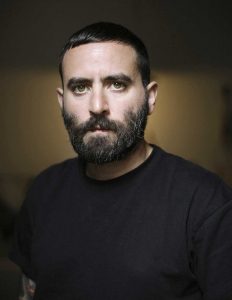Julia Sbriller & Joaquin Wall | Torontoides
(2020-2021) 02:17 mins
Selected by Fundacion Proa, Buenos Aires
In the film Torontoides, a group of people dive nude into the ‘unknown’, entrusting their lives to the rest of the team.
Through this repetitive act, artists Julia Sbriller and Joaquín Wall, in collaboration with Roco Corbould, image how to travel through an inner passage of the Earth, defying the laws of gravity and matter so far known, in order to unite the opposite poles of the planet to through an ‘intra-terrestrial channel’.
The short film reflects on the body that contains us and the wider mysteries of the planets, hemispheres and its magnetic fields.
Sbiller and Wall’s work centers around the possibilities of the human being to collectively connect with each other and individually (un)identify and transform itself.
Artist Q&A
Where are you from and how did you become interested in moving image work?
We are a multidisciplinary nomadic duo from Argentina and we are interested in video as a media that drives us into imagining actions and
spaces, as a way to create, experience and register our own imaginary realities. Video, as a moving image, translates perfectly the feeling we aim to create both for the spectators and the participants in the production of each piece.
What inspired/influenced you to make the work?
For Torontoides, we were particularly inspired by the torus and a new potential connection between both hemispheres of the Planet. In geometry, torus is a surface of revolution generated by a closed curve rotating around an axis. The torus is said to be the only energetic pattern that can sustain itself and that is made of the same substance as its environment. With Torontoides, we wanted to sculpt the planet into a huge toroid, from Argentina (where the piece was produced) to Canada, (where it was firstly shown).
We were also inspired by the possibilities of visually challenging the physical properties between the liquid and the solid, gravity and non-newtonian surfaces. We are always thinking about the body that contains us: the planet, its hemispheres, its magnetic fields and its mysteries.
What are you working on at the moment?
We are working on a new series about an intuitive approach to the telepathic property of water and the urge of creating huge sorbet (water based ice-cream) sculptures. We also are imagining a series of houses based on retro-futuristic water tanks we’ve been scouting around.
Julia Sbriller (1986, La Plata, Argentina) & Joaquin Wall (1986, La Plata, Argentina) are a multidisciplinary duo based in Argentina. Their work,
essentially hybrid and experimental, draws on a variety of mediums, including performance, architecture, sculpture, choreography, video and installation.
Their work has been exhibited in Swab Barcelona Art Fair (ES), Buenos Aires Photo (AR), Fundación Proa, Buenos Aires (AR), Munar Arte, Buenos Aires (AR), Art Gallery of Burlington, Ontario (CA), Bendita Tu Fest, Barcelona (ES). Julia and Joaquin are currently represented by Quimera Galería, in Buenos Aires, Argentina.
